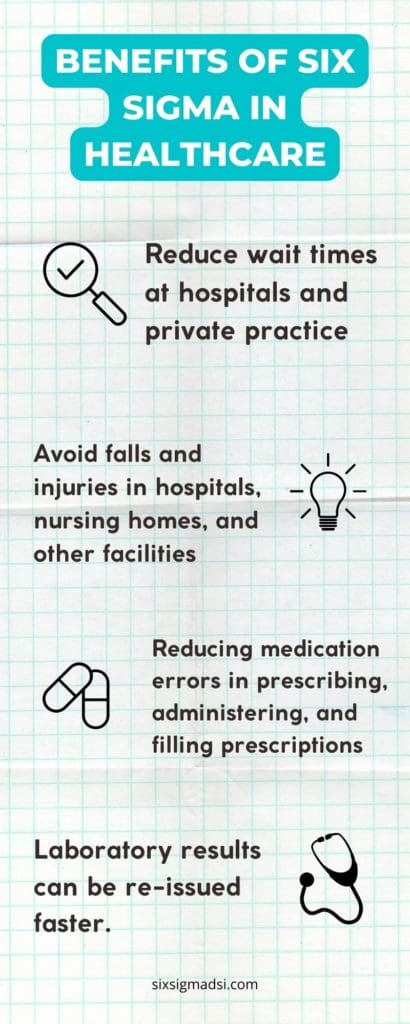Table of contents
- Lean Six Sigma for Hospitals
- Six Sigma can be used to improve the quality of healthcare.
- Six steps to mass customization in healthcare
- Benefits of Lean Six Sigma in Healthcare Hospitals
- Lean Six Sigma lessons and principles in health care Hospitals
- How to get certified in Lean Six Sigma Healthcare
- Related articles
Lean Six Sigma for Hospitals
Lean Six Sigma gives healthcare professionals in hospitals the tools and knowledge to perform well and accurately. The program also helps organizations deliver better performance and streamline their workflow. Lean Six Sigma health care professionals allow professionals to deliver principles results in complex, competitive environments with minimum inaccuracy.
Lean is a way to provide healthcare professionals with various tools and practices that improve efficiency and minimize waste while still providing quality services.
Lean Six Sigma can be used to improve healthcare quality. It can prevent inpatient injuries and falls in hospitals and nursing homes. It also helps reduce medication errors. Lean Six Sigma can reduce unnecessary costs and save time by correcting incorrect workflows.
Six Sigma’s DMAIC method focuses on improving existing processes. It guides each project step and applies the skills necessary to improve organizational performance. To achieve accurate results, it ensures that a logical and orderly workflow is maintained from the beginning to the end of the project.
The Six Sigma principles can be used in many industries to increase process efficiency and reduce waste. When used correctly, these methodologies can result in happier customers and higher revenue. Defects can significantly impact revenue and customer satisfaction in the healthcare industry. This can make the difference between life or death.
Healthcare professionals need to use Lean Six Sigma methods because they can reduce medical errors and defects. The United States has more than 210,000 deaths yearly due to medical errors. The healthcare industry is estimated to have lost $17.1 billion annually because of these errors.
Numerous federal agencies have tried to solve this problem by passing legislation and imposing regulations. However, healthcare professionals- practice managers, hospital administrators, or practitioners- can make a difference in their organizations by employing Lean Six Sigma principles.

Six Sigma can be used to improve the quality of healthcare.
- Reduce wait times at hospitals and private practice
- Avoid falls and injuries in hospitals, nursing homes, and other facilities
- Reducing medication errors in prescribing, administering drugs, and filling prescriptions
- Laboratory results can be reissued faster.
Six Sigma can help reduce expenses. Healthcare professionals can achieve these results using proven Six Sigma or Lean methodologies in hospitals. For example, the DMAIC method (Define, Measure, Analyze and Improve, Control) focuses on improving processes. The check-in is one of the most essential processes in a hospital setting. This is how DMAIC could simplify this process:
Define
- Identify the issues and set goals.
- Create a process map detailing each step.
Measure
- Take a look at the performance of your current check-in and collect data for each step.
- Identify bottlenecks – where is the process slowing?
Analyze
- Analyze the data from each step and look for elements that could be eliminated or simplified.
- Identify the root cause of bottlenecks.
Improve
- Test and develop solutions to improve check-ins. Can insurance information be obtained before patient arrival in non-emergencies? Can nurses and doctors be more coordinated?
Control
- You can ensure that the new check-in procedure is on track by regularly monitoring and documenting any improvements.
- Create a control chart to determine how effective the new process is over time.
The first step in streamlining the check-in process is to make it easier. There are many successful Lean Six Sigma examples in healthcare, from making clinical research more economical to decreasing appointment cancellations. Healthcare professionals who have Lean Six Sigma certifications will be in high demand. Lean Six Sigma training can help employees in the areas of quality management, consulting, and patient experience. They can also be trained to become leaders in healthcare management.
Six steps to mass customization in healthcare
Instead of relying on guidelines alone, healthcare systems should employ a clinical management approach to create shared baseline protocols. This is the healthcare version of “mass customization,” as it is commonly known in lean terminology. It combines low unit costs and the flexibility of individual customization. This approach can be used in healthcare by following six steps:
- Identify the most crucial clinical process.
- Create an evidence-based best practices protocol. This is important to remember that it’s always imperfect due to poor evidence or the unreliability of a consensus approach for the best practice. However, those issues can be resolved later.
- The protocol can be blended into the clinical workflow to avoid human memory dependence. This is often referred to as clinical decision support. This creates the notion of “best care,”
- the lowest energy state for nurses and doctors. It’s a default option that occurs automatically unless it is modified by someone else.
- Embed data systems can track protocol variations and short-term patient outcomes (i.e., intermediate and final clinical, cost, and satisfaction outcomes).
- You should insist that clinicians adapt the protocol to meet individual patient needs. This customization is possible after the production process has been completed in Steps 1 through 4.
- In a continuous-learning loop, feed data on outcomes and variations to the protocol. This is a lean-based continuous learning loop that continuously updates and improves it.
- Having a “thinking brain” is essential when working with mass customization. This person understands that there are no two people alike and adjusts accordingly. While variation is acceptable in and of itself, standardization is the key to effective variation. Standardization is established at the front so that people can differ around them. This information then goes through the learning loop to continually improve the protocol. The protocol is no longer “best practice” but an iterative process that continuously improves and communicates with the other care team members.
Benefits of Lean Six Sigma in Healthcare Hospitals

Lean Six Sigma lessons and principles in health care Hospitals
Healthcare systems that follow a lean approach to healthcare learn four important lessons.
- They are proud of their achievements in life. Although the healthcare industry is far from the miracles it could be, patients can have dramatically improved outcomes if treated with a lean approach. This transformative approach to healthcare drives the industry and profession forward remarkably.
- This is not a new concept, but it requires a team and better process-aligned data systems. Since at least 60 years ago, the healing professions have used a team-based healthcare approach. They don’t give it fancy names or try to market it as a service. Healthcare professionals adopted the idea that there are agreed-upon standards that allow for effective customization based on patient needs. The ability to use data systems for transparency to allow everyone to learn from the best variations and benefit from them makes this different. Organizations must also think about care processes to focus on patient-centered healthcare. Quality improvement, the science of improving these processes, allows for a more robust approach to population health. It emphasizes cost-effective preventive rather than costly rescue care.
- Most of the time, cheaper care is better. The Iron Triangle of healthcare delivery comprises quality, cost, access, and accessibility. A lower cost of care is a good thing in an industry with low margins. Access to quality care is not possible without it. Accessibility doesn’t mean that a patient can walk in; it also means that the community members can afford the care.
- Aligned financial incentives are essential for the long-term viability of clinical quality improvement programs. Vertical integration, consolidations, mergers, and acquisitions dominate healthcare news. This is a powerful force in an industry with as much as $2 trillion of waste. There is always a consolidator who will remove that waste from the system. It pays to be lean, both for the organization’s long-term well-being and the future of healthcare.
How to get certified in Lean Six Sigma Healthcare
A high-quality Lean Six Sigma certification program can help healthcare professionals advance their careers and give them a competitive edge. A Lean Six Sigma Green Belt Certificate or Six Sigma Black Belt certification is required for many leadership positions in the healthcare sector. Green Belt holders have a good understanding of LSS methods and can supervise some projects or help Six Sigma Black Belt holders qualified to manage high-level tasks.
Do you know of any hospitals that use Lean Six Sigma Methodologies in Healthcare?
Tell us about it in the comments below.












